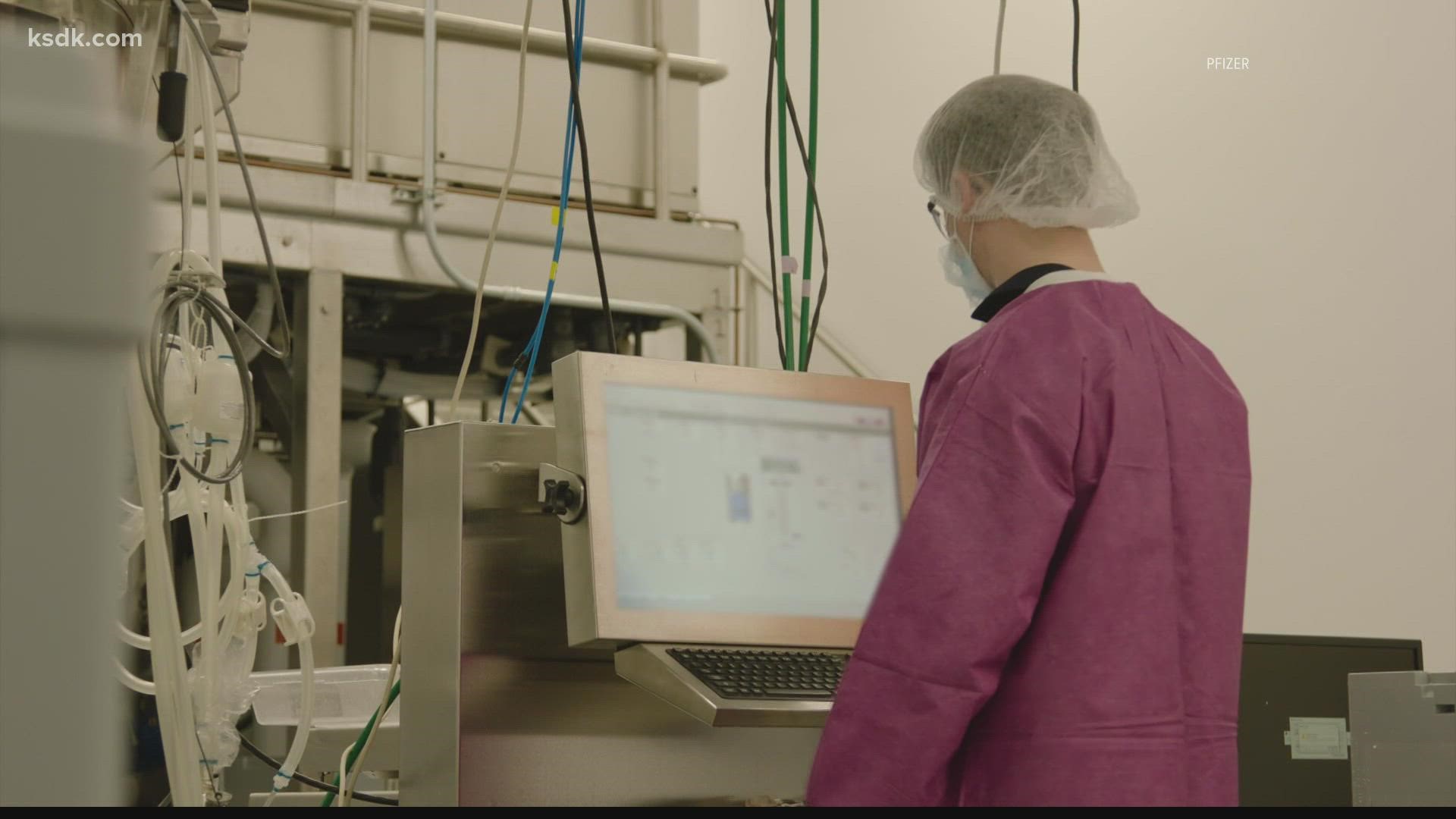CHESTERFIELD, Mo. — Justin Sperry is Pfizer's Vice President of Transformational Technology and the Sitehead of the Chesterfield location.
He's been with Pfizer for almost 14 years, but for the first time in 2020, the company faced a new virus that changed everything.
COVID hits in the U.S.
"Almost two years to the date, we started reading the news about the respiratory virus," Sperry recalled.
100 weeks ago, on January 20, 2020, the CDC confirmed the first laboratory-confirmed case of COVID-19 in the U.S.
"It was not even a month later that we knew that this was going to be a big issue," Sperry said.
Not too long afterward, leaders told them they would be developing a vaccine.
"We were all seeing the news, the headlines people were very sick, people were dying and that really motivated us to bring together our scientific capability and manufacturing capability to help people around the world. It was probably Pfizer's largest risk in its 160 to 170 year history as a company," Sperry said.
For them, it was a risk worth taking. To do this, it required a tremendous amount of work and flexibility because they, too, were trying to protect themselves against the virus.
"We had colleagues working evenings, days, and weekends," Sperry said. "All trying to adapt to all of this flexibility that we needed."
What the Chesterfield site does
The Chesterfield location is a part of Pfizer's development portfolio for biologics.
Staff work on vaccines, antibodies and gene therapies for the disease areas they're interested in.
The site focuses on three areas:
- They develop the manufacturing process for a majority of the biological products and these are all going into clinical trial
- They develop all of the testing approaches to ensure they understand the process and understand the product
- The final step is what the clinician sees and what the product actually looks like in the hands of the patient
"We have some of the world's renowned experts and DNA technology," Sperry said.
How COVID affected them
When COVID came into the mix, a big problem was that other diseases kept going, as well.
Many of the other medicines they were developing still needed to be produced and tested.
"While we had to prioritize the COVID vaccine, all of these other things still needed to get done," Sperry said. "So, our focus is still spread throughout the portfolio, we have about 50 to 60 active programs within the portfolio. But our large effort is on the COVID vaccine."
Laser focusing their efforts on COVID-19 meant more hands on deck.
The Chesterfield site hired approximately 150 new scientists to assist in handling the extra workload.
At any given moment, hundreds at the St. Louis County location were hustling to get this vaccine rolling out.
It was a race against the clock to see who could move quicker. The virus or the makers of the vaccine.
Results
"We were involved in the manufacturing of the first step of the process for the COVID vaccine. In fact, we were responsible in Chesterfield for supplying the world with this DNA template, so that it could be used for the manufacturing process," Sperry said.
Another important attribute the facility made was testing.
"The testing of all of the manufacturing controls and consistency of the product, that was done here. Every dose that was distributed in the United States was tested in our quality labs here in the St. Louis site," Sperry notes.
On Dec. 11, 2020, Pfizer's COVID vaccine became the first to get an Emergency Use Authorization (EUA) from the Food and Drug Administration.
"When we received the Emergency Use Authorization, we all had a celebratory moment, but we knew that that was just the beginning," Sperry said.
Production numbers
Once they got the EUA green light, Sperry said they expected to produce 800 million to one billion doses in 2021.
"That’s a number we've never produced in a single year ever," he said.
But now, they're distributing the vaccine in more than 162 countries and approaching almost three billion doses distributed.
There have been more than 500 million doses of the vaccine administered in the United States.
In Missouri, a majority of vaccinated individuals received the Pfizer vaccine, about 58% of the 3,232,415 people fully vaccinated as of Dec. 21.
What's next?
As far as distribution, Sperry hopes they can manufacture four billion doses next year.
And they're equipped to adjust its product.
"We've actually already started making the DNA template for the omicron variant, in case we need to make an omicron-specific version of our vaccine," Sperry said. "Vaccines are really the best way to get ahead of the virus."
If other variants of concern emerge, he said they have the ability and technology to rapidly respond.
"We can generate a DNA template, create the vaccine, and work with regulators within about 100 days to distribute a vaccine specific to that," he explains.
As the pandemic drags on and new variants arise, their efforts haven't changed.
"Every single person really wants to make a difference in the patient. We're all affected by a disease. Every single person that works here knows somebody that is in need of medicine. That's what really drives the passion and motivation for our scientists. We want to contribute, we want to use our gifts as scientists and provide an opportunity," he said.
The Pfizer Chesterfield location is currently hiring.
Sperry says they are looking for someone who is willing to work on a team and ready to dig into projects.
To look for those opportunities, click here.

